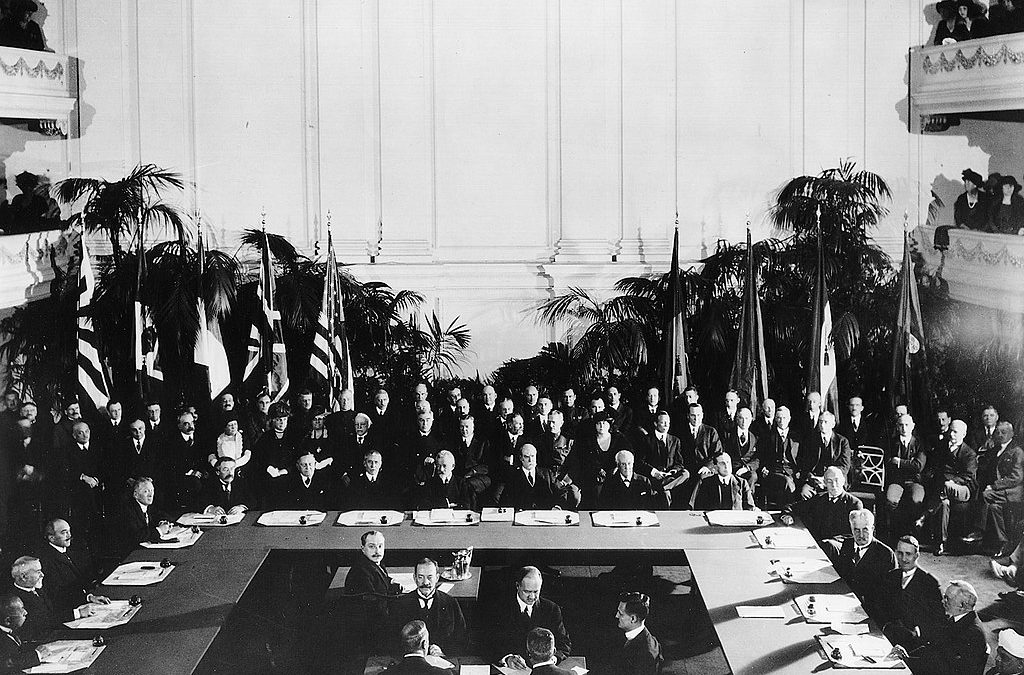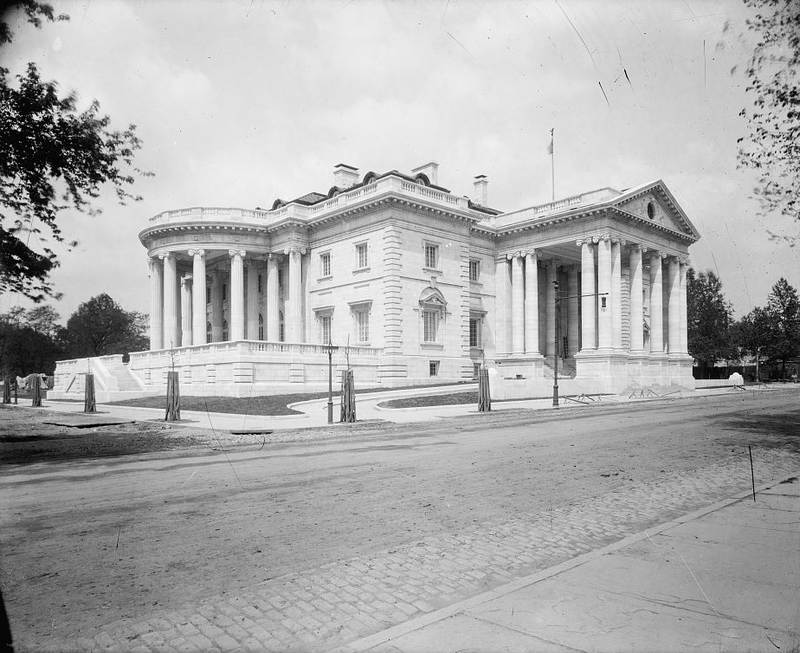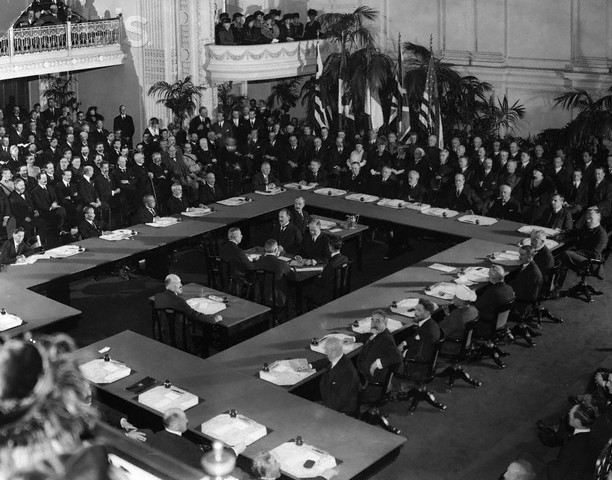The term ‘Washington Treaty’ frequently appears in specialist naval books and even general histories of the inter-war period. There is no mistaking the meaning: it refers to the treaty signed on 6 February 1922 between the United States, Britain, Japan, France and Italy, setting naval strength limits and establishing the precedent for a system of conferences and treaty-defined limitations that lasted well into the 1930s.
What this hides is that the term is technically a metonym, replacing the formal name of the agreement with the place where it was negotiated. The actual title of the naval treaty at the time was ‘Five Power Treaty’, because it was one of three major treaties and a range of smaller agreements reached during a significant international conference held in Washington between 12 November 1921 and 6 February 1922. The plenary (public) sessions were hosted by the Daughters of the American Revolution (DAR) who provided premises, the Memorial Continental Hall.[1]
The conference was originally called on 10 July 1921 by US President Warren Harding purely to discuss naval disarmament and end the growing naval race between Japan, the United States and Britain. The announcement was no surprise: diplomats had been laying the practical groundwork for some time, and Britain, the United States and France accepted just a week later, although Japan did not until 24 August. Italy consented to join on 1 September. Invitations were then sent to Belgium, Holland and Portugal on 4 October. All three had significant interests in the Far East, and their inclusion reflected the fact that the conference was gaining a more significant diplomatic role as arrangements were made for it during the second half of 1921. As all the main powers realised, the conference was also an opportunity to deal with outstanding matters in the Far East, including the Anglo-Japanese Alliance which was up for renewal, and to which the United States was opposed. As a result, discussions over diplomatic relationships and treaty arrangements in this region were as much a focus of the meetings in Washington as the naval arrangements. They were not unrelated, of course.
Each of the three major treaties was named after the number of signatories. The first was the ‘Four Power Treaty’ signed on 13 December 1921, an agreement between Britain, United States, Japan and France to consult if any crisis arose in Asia. This replaced the two-party Anglo-Japanese Alliance, which had been up for renewal in July 1921, and which Japan was eager to keep. As such it represented a significant shift in the power balances across that region, primarily in United States favour; and has been described as a ‘major diplomatic coup’ on the part of the State Department.[2]
The second major arrangement was the ‘Nine Power Treaty’, signed on 6 February 1922. This was intended to stabilise and define international interests in China. It was accompanied by a range of smaller arrangements, mostly signed on 1 February 1922, relative to postal agencies, armed forces, radio stations, Chinese railways, military forces, and confirming requirements by the signatories to notify each other.[3] All of this did much to establish world relationships and power balances during the remainder of the 1920s.
The naval treaty was signed the same day, underscoring these new power balances with its 5:5:3 ratios for the world’s main naval powers. Its formal diplomatic title was hinted at by the New York Times on 2 February 1922 when they published articles under the headlines ‘Five Powers Adopt Navy Limit Treaty’ and ‘Draft of Five-Power Naval Limitation Treaty As Accepted by Conference’.[4] The ‘Five Power Treaty’ was signed on 6 February by representatives from Britain and its key Dominons, the United States, Japan, France and Italy.[5] This achieved one of the main intended goals of the conference.
What nobody seemed to agree on was a descriptive nickname for the naval treaty. Formally, in diplomatic terms, it remained the ‘Five Power Treaty’, which is the title given in the US State Department archive.[6] This, however, wasn’t very informative, and that was well recognised in US circles at the time. In Japan it became (via translation back to English) the ‘Treaty between the five powers concerning the limitation of naval armament’.[7] Other governments named the parties in various orders. The Australian government, for instance – which was signatory as a self-governing Dominion within the British Empire – referred to it as the ‘Treaty between the British Empire, the United States of America, France, Italy and Japan, for the Limitation of Naval Armament’.[8] It was also signed by New Zealand, where it was known by the subtly different title ‘‘Treaty between the United States of America, the British Empire, France, Italy and Japan, for the Limitation of Naval Armament’.[9]
In the end, though, the arrangement became known simply as the ‘Washington Treaty’ – a descriptive tag that, as noted earlier, was actually a metonym. How did this happen? Naval strength was one of the major ways in which power-balances were measured. There was little danger of confusing the naval treaty with any of the other treaties signed during the conference, and the naval treaty, alone, gained the general moniker ‘Washington’, to the point where by 1936 – as one example – Parliamentary debate in Britain referred to the ‘Washington Naval Treaty of 1922’.[10] So the popular nickname for the ‘Five Power Treaty’ became, by general usage and convenience, ‘Washington Treaty’. And so it remains – broadly speaking – today, a century on.
For Additional Info about the Washington Treaty, check out the following article!
How Britain gained two new battleships from the Washington Naval Conference
For more on naval history, my book on HMS New Zealand is published by Seaforth and USNI Press. Check it out.
[1] ‘The Conference on the Limitation of Armament’, Daughters of the American Revolution Magazine, Vol. 56 No.1, January 1922.
[2] Edward Joseph Chusid, ‘The Concurrent Conferences: The Washington Naval Conference and the Far Eastern Affairs Conference of 1922’, MA thesis, Eastern Michigan University 2008, P. 64.
[3] Charles I. Bevans (ed), Treaties and other international agreements of the United States of America 1776-1949, Vol. 2, Multilateral 1918-1930, Department of State Publication 8441, Washington 1969, pp. 309-345
[4] New Tork Times, 2 February 1922.
[5] See, e.g. https://history.state.gov/milestones/1921-1936/naval-conference
[6] https://2001-2009.state.gov/r/pa/ho/time/id/88313.htm
[7] https://worldjpn.grips.ac.jp/documents/texts/pw/19220206.T1E.html
[8] http://www.austlii.edu.au/au/other/dfat/treaties/1923/9.html
[9] AJHR 1922 A-5, ‘Conference on the limitation of armaments, report of Sir John Salmond, delegate for the Dominion of New Zealand’.
[10] https://hansard.parliament.uk/commons/1936-11-18/debates/625daf44-9c16-4871-803a-2079ec5e4aec/WashingtonNavalTreaty





Recent Comments